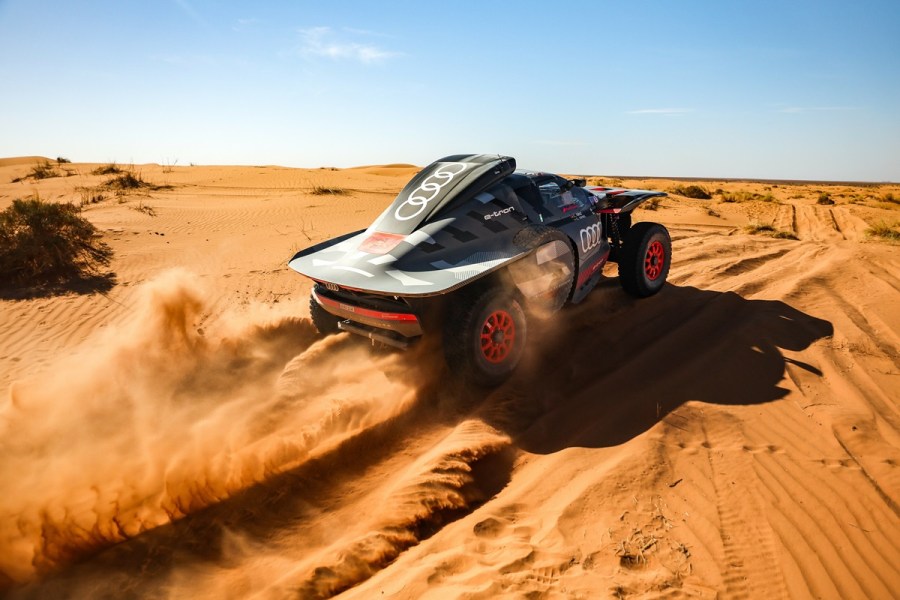The Dakar Rally is one of the most grueling motorsport events in the world, and tends to feature some pretty epic cars. Here’s the four main factory contenders vying for victory in 2024.
Admittedly, off-road builds aren’t usually our thing here at Fast Car, but in the case of the Dakar Rally, the ‘cars’ involved – if we can even call them that – are simply too fun to turn a blind eye to.
Fans of the famous cross-country race will know that drivers and riders can enter all sorts of vehicles into the Dakar Rally’s multitude of different classes. Bikes, buggies, quads – even full-size trucks! However, the stars of the show tend to be the cars. These often involve the best styling, best tech and best drivers, and 2024 is no different…
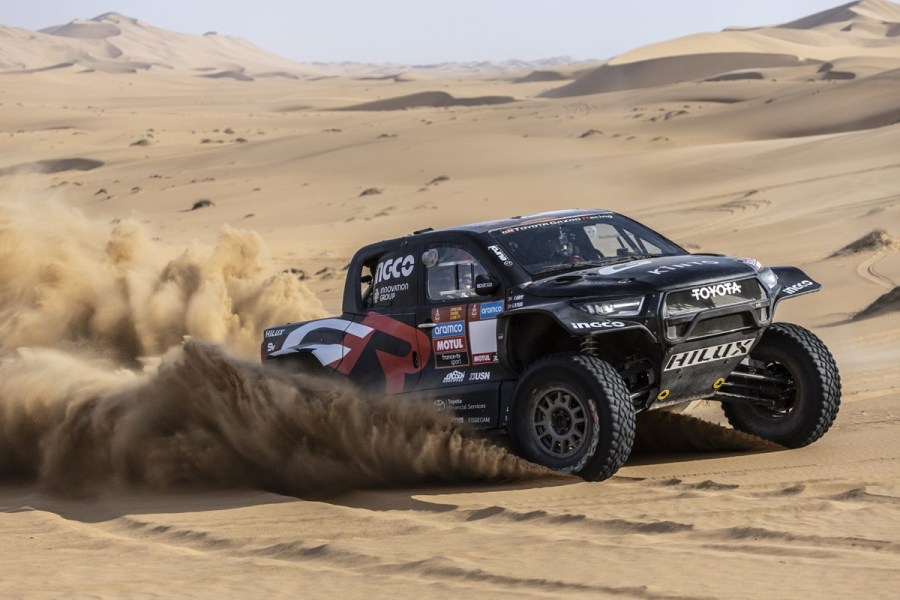
Toyota GR DKR Hilux EVO T1U
If you broaden your motorsport horizons beyond the closed paddock of F1, you’ll quickly begin to realize that Toyota Gazoo Racing is an absolute powerhouse. This has been the case for a good few years, but last year alone, Toyota won the FIA World Endurance Championship, FIA World Rally Championship, and the Dakar Rally, at a relative canter. The only blot on their otherwise immaculate copy book was coming second to Ferrari at the 24 Hours of Le Mans.
Intending to start 2024 on a similar high, Toyota Gazoo Racing is back again to defend its Dakar crown. However, things are a little different this year. For a start, the team has a whole new look. Gone is the iconic white and red livery of years past, and in its place comes this stealthy black number. For brand alignment’s sake, you’ll see this dark new aesthetic on Toyota’s WRC Yaris fleet and WEC Hypercars too.
That’s not all though. See, Toyota has parted ways with its former star driver, Qatari sporting hero Nasser Al-Attiyah. Without him, the Japanese marque faces an uphill battle to retain its position on the top step of the Dakar podium. That said, Toyota’s fresh five-strong squad of drivers aren’t without their own prestige in rally-raid circles. Lucas Moraes steps up to the factory team after finishing third in last year’s Dakar for privateer Team Overdrive, and he’ll be joined by Seth Quintero, a young graduate from the ‘buggies’ class. Giniel de Villiers is an experienced veteran of the sport, while rookie Saood Variawa joins TGR from the South African Global Touring Car Championship. Guy Botterill, another Dakar rookie (albeit an established rally ace), completes the line-up, substituting for the injured Henk Letigan.
Not your average Hilux
Upon first glance, it’s easy to tell that this is no ordinary Toyota Hilux. In fact, aside from the silhouette, there’s little that this wild pick-up shares with its roadgoing namesake. The engine, for instance, is based on one of Toyota’s production blocks – but not one that you’ll find in the humble Hilux. Instead, this Dakar special runs a modified version of the V35A twin-turbo petrol V6, found in the Land Cruiser SUV. In stock form, the V35A outputs 410PS, but for the Dakar, sporting regulations mean that Toyota has had to detune it to around 360PS. Still, that’s plenty to be playing with, especially with 457lb ft of torque on tap.
During the winter off-season, the Hilux has undergone a number of small evolutions. Its track is now 100mm wider, and the air conditioning unit has been relocated for better efficiency. As well as airing the drivers, Toyota has also upgraded the engine’s cooling system. As for the rest of the Hilux’s design, there’s no need to fix something that ain’t broken.
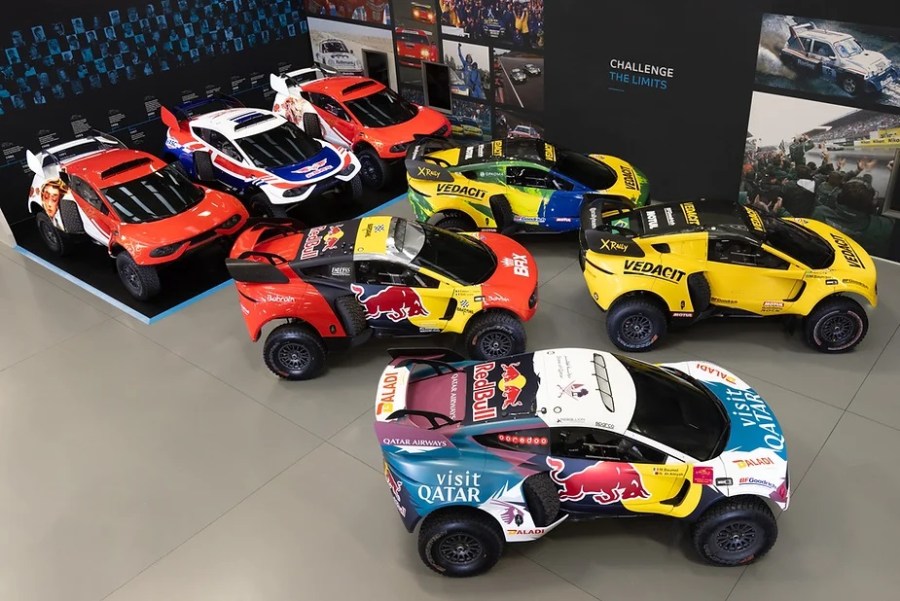
Prodrive Hunter
Based on last year’s form, Toyota’s biggest threat for victory could be Prodrive. Up against the might of OEM constructors, it’d be easy to assume that a small organization like this might be an underdog. However, let’s not forget what Prodrive is. Sure, it may be a little company tucked away in the British midlands, but Prodrive was the driving force behind Subaru’s WRC dynasty. When it comes to off-road racing, these guys know what they’re doing.
Nowadays though, they aren’t operating under the guise of another manufacturer. Instead, the Prodrive Hunter is a self-titled album, designed to prove exactly what Prodrive stands for. It’s quite an attractive-looking thing too. Sure the front end won’t be everyone’s cup of tea, but we’re a fan of its high-riding coupe-esque proportions. And, maybe it’s just us, but the Hunter’s rear lights seem rather reminiscent of some current Jaguar models.
Underneath its brawny exterior, the Prodrive Hunter makes use of a 3.5-litre twin-turbo V6 like the Toyota Hilux mentioned above. However, the block you’ll find in the Hunter’s engine bay is based on a modified Ford Ecoboost motor.
Star-studded drivers
Arguably, what makes Prodrive the biggest threat to Toyota is not simply its engineering prowess, but its two star drivers. 9x World Rally champion Sébastien Loeb placed second in the Dakar last year, and for 2024, he’s joined at Prodrive by former Toyota man Al-Attiyah. I’d be surprised if those two weren’t the bookies’ favorites.
You might be wondering why Al-Attiyah would trade a Toyota factory contract for a Prodrive one, but that equation starts to make more sense once you factor in the news that Prodrive will evolve into the new Dacia factory team in 2025…
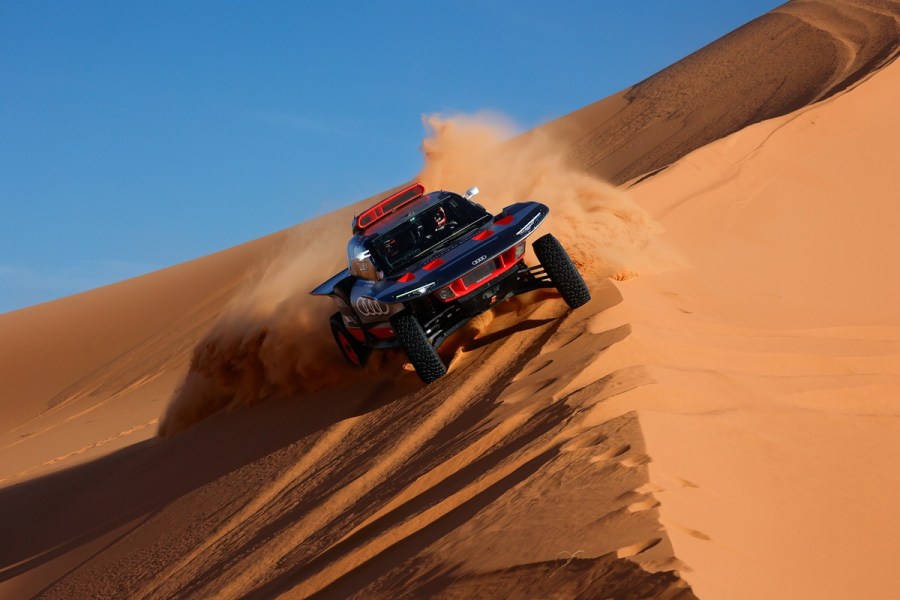
Audi RS Q e-tron
So far, Audi’s foray into the Dakar Rally has been a tricky one. The Audi’s RS Q e-tron is the most innovative Dakar machine in the car category, and as such, it’s needed a slightly more extensive development phase to truly become competitive. Couple that with a heavy dose of bad luck in both 2022 and 2023, and the big results haven’t yet come the German marque’s way. However, that innovation which has caused some of the trouble, has also led to the Audi RS Q e-tron being the most widely spoken-about car on the grid. Whereas Audi’s rivals rely on combustion, the RS Q e-tron takes on the desert dunes with battery power. As a result, what we have is a full-on tech war at the top of the Dakar tree, which Audi is keen not to lose.
So, how exactly does this SUV-spaceship lovechild work? Well, two Formula E-sourced electric motors propel it along. However, it’s not exactly easy to find a charging station in the middle of the desert, so to get around that issue, the RS Q e-tron charges itself. To do that, it relies on a neatly tucked-away 2.0-liter TFSI DTM petrol engine. It’s worth pointing out though that the thoroughbred four-cylinder never actually moves the car along. Instead, it’s simply there to power an onboard generator, which then charges the electric propulsion motors.
Make or break?
With two competitive years under its belt, Audi has been able to move on from developing the core concept, and instead gone down a more specific upgrade plan for 2024, in line with the likes of Toyota. For Audi, a big focus in the off-season has been on improving comfort for the crew inside the cabin. If Audi’s drivers and navigators aren’t buffeted around so much, it stands to reason that they’re likely to perform better and make less mistakes.
Interestingly, Audi has paid particular attention to the way that the car travels across soft sand too, rather than any of the other terrain variants that the teams come across during the event. According to factory driver Mattias Ekström, the revisions should allow the drivers to traverse big dunes without so much of a need to be constantly shifting in and out of different gears, making the driving process more efficient.
Multiple DTM champion Ekström will once again partner veteran stalwarts of the Dakar, Stéphane Peterhansel and Carlos Sainz. Given the number of accolades that this trio shares between them, there can be no doubt over the quality of Audi’s driver roster. All they need to do now is put the full package together – luck included.
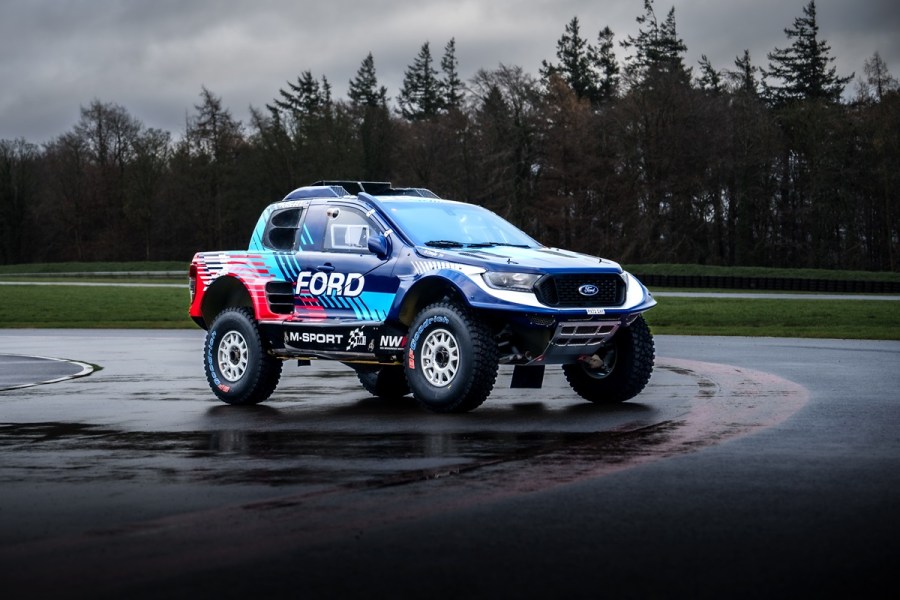
Ford M-Sport Ranger Raptor T1+
Ford is the new kid on the block. The fourth full factory effort in this year’s edition of the Dakar ensures that the car category will enjoy its deepest, most competitive entry list for a very long time. However, as Audi and Prodrive found out at the start of this decade, it’s not easy to come into this event and be fighting for victory right away. As such, it’d be a minor miracle if the team was to win on its first outing, but we shouldn’t discount them from potential podium or top five contention.
The organizations running and developing Ford’s factory Dakar effort are Malcolm Wilson’s M-Sport outfit, and Neil Woolridge Motorsport (NWM). Both have a long-standing association with the Blue Oval, especially M-Sport, having run Fords in the WRC for more than twenty years. This, however, will be Ford’s début at the Dakar.
First impressions
As far as appearances go, the M-Sport Ranger is much more recognizable as a ‘car’ than the Audi is. But, like Toyota’s Hilux, there are few similarities between it and the average roadgoing Ranger pickup. As per the regulations, it’ll be running a tuned 3.5-liter EcoBoost V6, but to be honest it’s not worth getting too bogged down in the tech specs of this Ranger. Ford has already admitted that, since this car is based on an old formula, there will be an all-new Dakar Ranger coming in 2025. This year then, is largely a dress rehearsal for the main push in years to come.
Piloting the Rangers in 2024 will be Dakar veteran Nani Roma (formerly of Prodrive), and NVM’s Gareth Woolridge.
The Dakar Rally always provides some pretty brutal automotive entertainment. So, if you find yourself with a spare few minutes over the next week or two, follow the highlights of this year’s event over at the official Dakar YouTube channel. The first official day of the rally is Saturday 6th January, 2024.

